Masterpiece Story: Portrait of Madeleine by Marie-Guillemine Benoist
What is the message behind Marie-Guillemine Benoist’s Portrait of Madeleine? The history and tradition behind this 1800 painting might explain...
Jimena Escoto 16 February 2025
29 December 2024 min Read
Giorgione and Titian’s Sleeping Venus is a masterpiece of the Venetian Renaissance school of painting. It explores sensual nudity through a classical mythological veil.
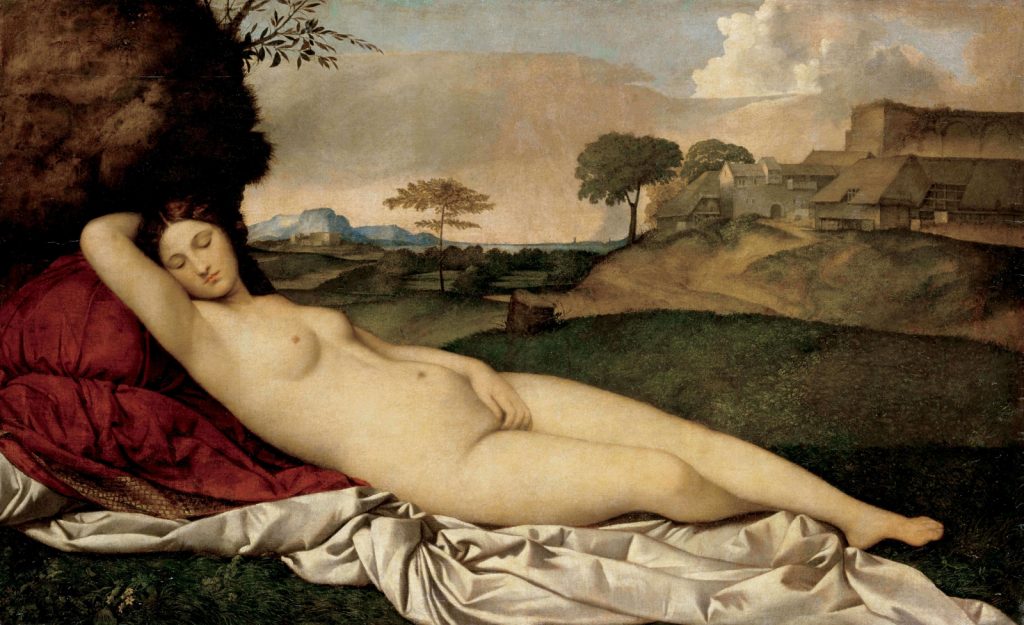
Giorgione and Titian, Sleeping Venus, 1508-1510, Gemäldegalerie Alte Meister, Dresden, Germany.
The Italian city of Venice has long played an important role in the development of Western art. It was especially powerful in the late 15th and 16th centuries when it cultivated a flourishing, independent, and influential school of art. The Venetian School promoted soft lighting, sensuous colors, and shadowy outlines. It had a sense of poetry, or poesia, that explored nature’s beautiful landscapes and humanity’s delightful pleasures. Giorgio da Castelfranco, known as Giorgione, was a Venetian master of poesia – paintings inspired by or painted in an indirect “style” of classical ancient poetry. His Sleeping Venus is a masterpiece of this type of paintings and the larger Venetian School.
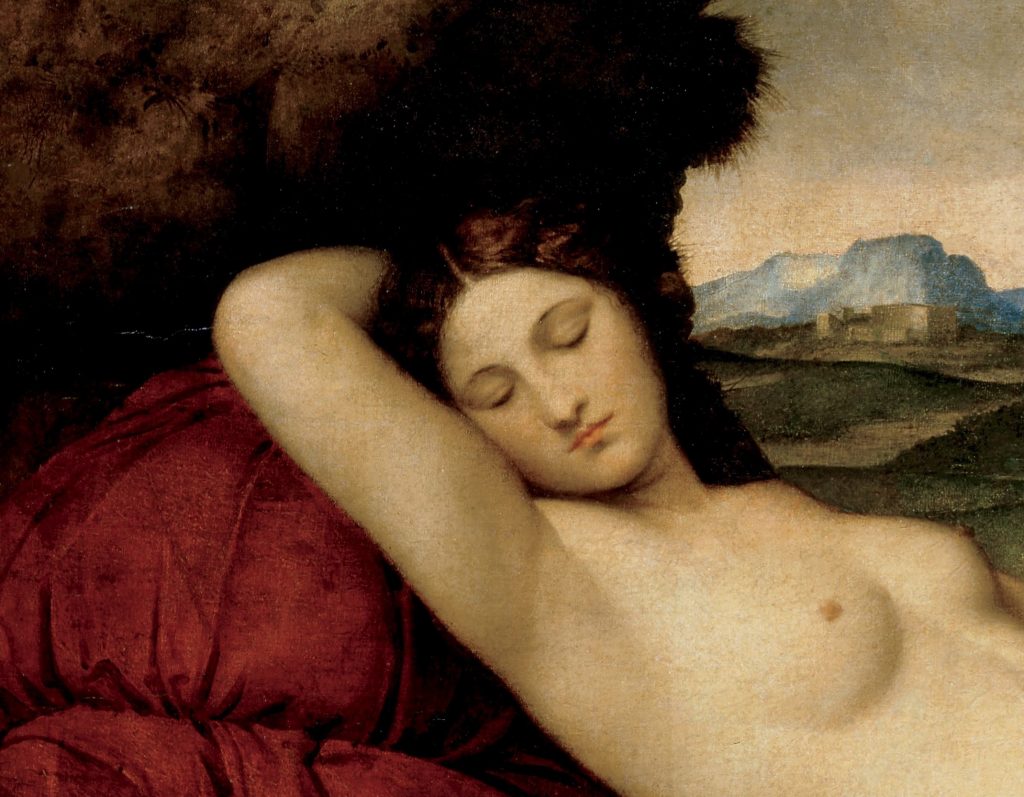
Giorgione and Titian, Sleeping Venus, 1508-1510, Gemäldegalerie Alte Meister, Dresden, Germany. Detail.
Sleeping Venus by Giorgione is an oil on canvas in landscape orientation measuring 175 cm (69 in) wide and 108.5 cm (42.7 in) high. It features a very beautiful nude woman reclining in an idyllic Italian landscape. The unclothed woman is sleeping in a peaceful position as she is softly bathed in warm sunlight. Her right arm is outstretched behind and supporting her head. Her left arm is listlessly lying atop her body and drapes across her pubic area. The woman’s legs are crossed with her left leg atop her right leg. She reclines against a large red cushion while she slumbers upon a crumbled white sheet. A rolling landscape of hills provides a peaceful backdrop to the woman’s nap.
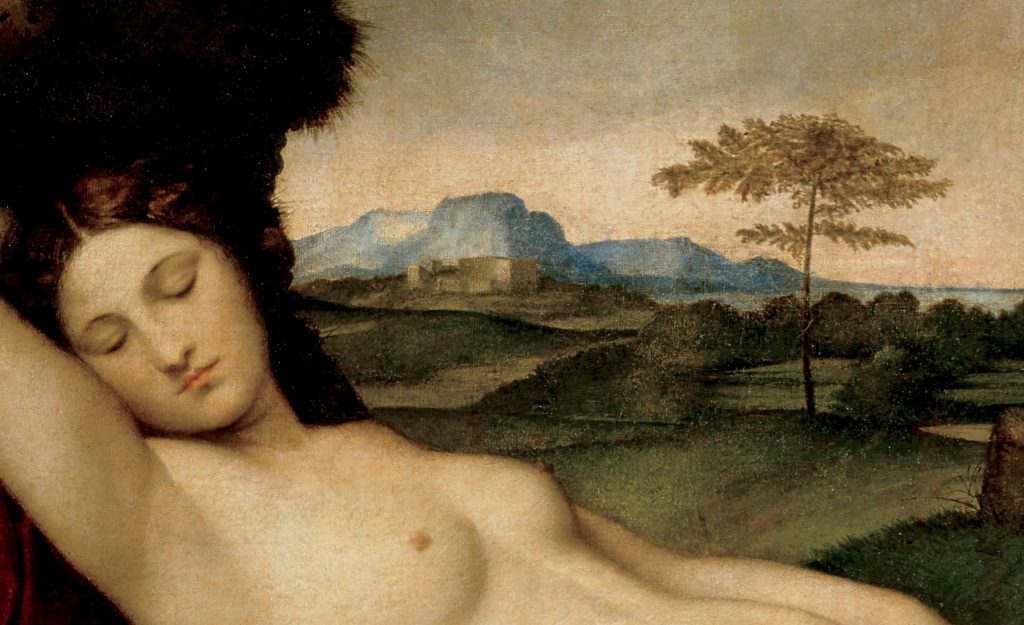
Giorgione and Titian, Sleeping Venus, 1508-1510, Gemäldegalerie Alte Meister, Dresden, Germany. Detail.
The unclothed woman is Venus, the Roman goddess of erotic love and feminine beauty. Since the ancient Roman Empire, the goddess Venus has been a popular subject in the arts, especially in painting and sculpture. Her physically beautiful charms and her energetic sexual life allow artists many opportunities to explore the nude female form within the respectable guise of Classical mythology. Venus was the wife of Vulcan, the Roman god of metalworking; the lover of Mars, the Roman god of war; and the lover of Adonis, a beautiful mortal hunter.
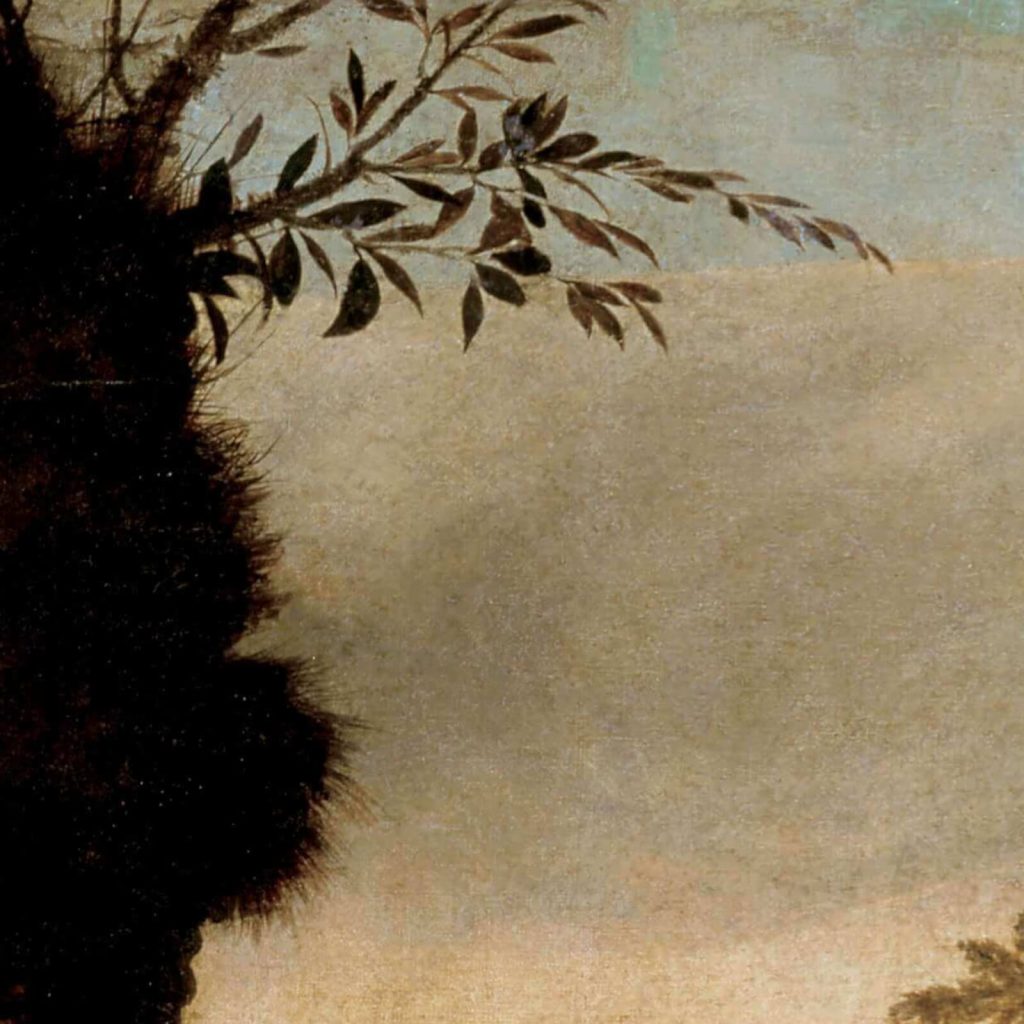
Giorgione and Titian, Sleeping Venus, 1508-1510, Gemäldegalerie Alte Meister, Dresden, Germany. Detail.
Giorgione has painted an unusual Venus because she is not instantly recognizable compared to contemporary paintings by other artists. Venus does not have her usual attributes such as doves, swans, scallop shells, red roses, a mirror, or Cupid. Nothing truly indicates that Giorgione’s nude woman is a Roman goddess. However, this visual enigma was not always the case for this painting.
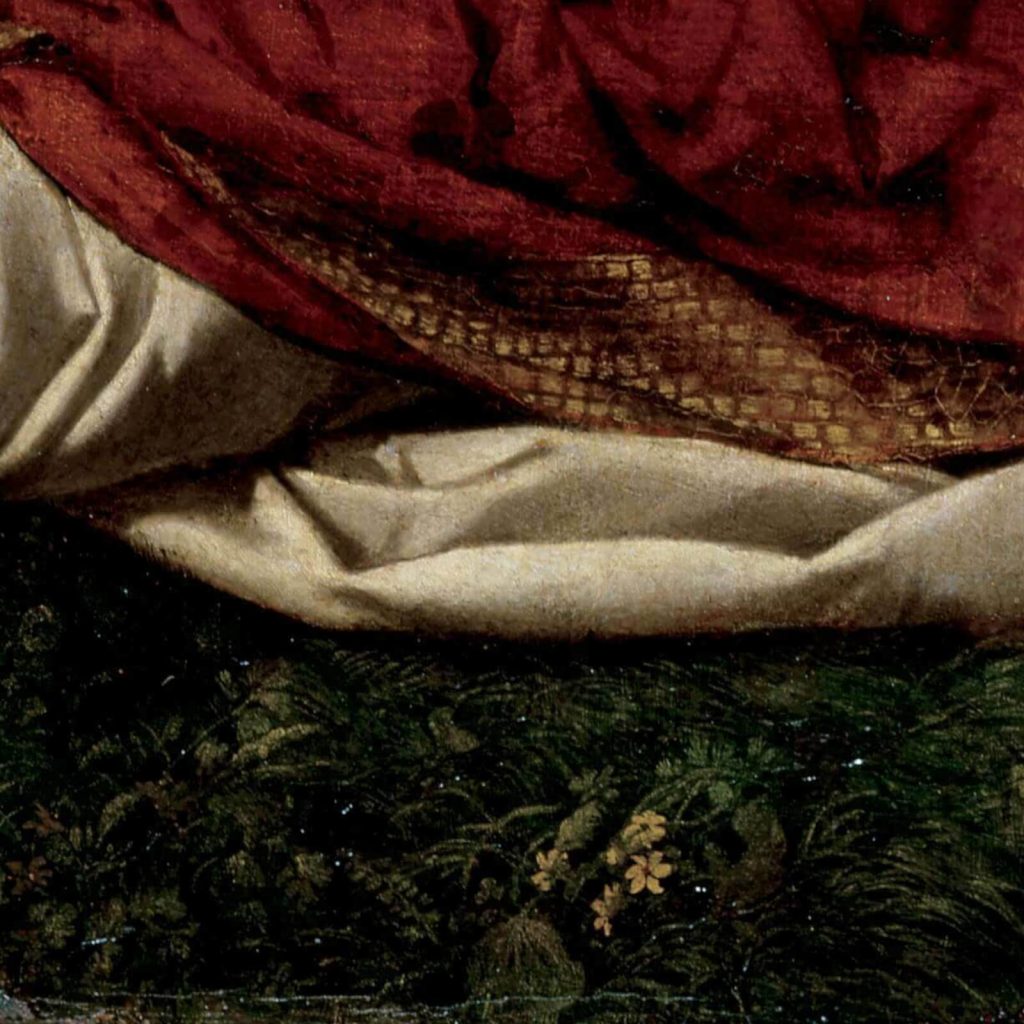
Giorgione and Titian, Sleeping Venus, 1508-1510, Gemäldegalerie Alte Meister, Dresden, Germany. Detail.
Back in 1510 when Sleeping Venus was completed, it featured baby Cupid sitting at the feet of Venus. Cupid, the Roman god of desire, is the illegitimate love child of Venus and Mars. He is famously known to have golden arrows of desire and lead arrows of repulsion. He would shoot these arrows into the hearts of potential lovers to create mutual attraction or amusing one-sided chasing. Cupid was originally displayed as playing with his bow and arrows. However, over several centuries, his image was poorly preserved and in 1837 a restorer decided to paint Cupid out of the picture with a green landscape. Cupid’s previous existence was recently confirmed by 20th-century X-ray images. They also showed that Venus’s face was originally in profile but later painted to her present full-frontal position. Therefore, this 19th-century version of Photoshop altered the picture from an explicit profile goddess to an unknown frontal mortal.
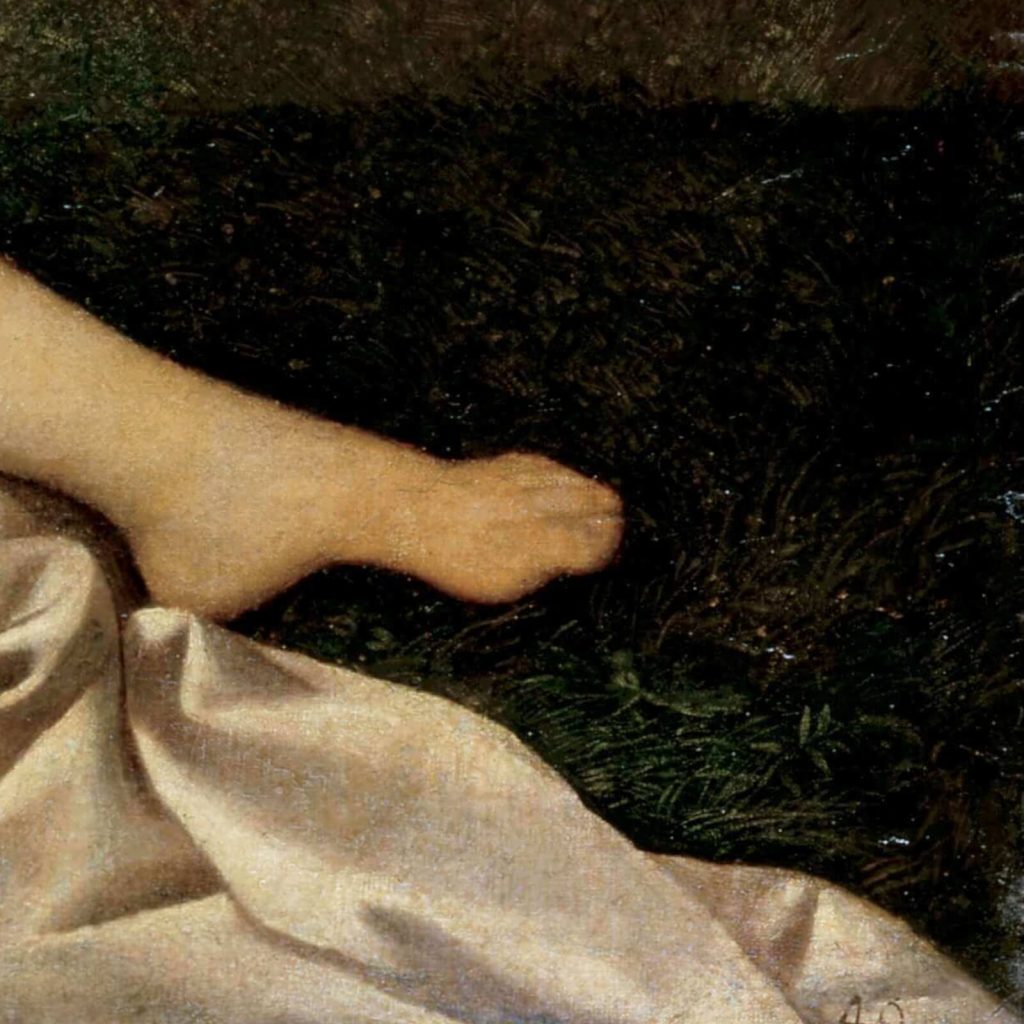
Giorgione and Titian, Sleeping Venus, 1508-1510, Gemäldegalerie Alte Meister, Dresden, Germany. Detail.
Giorgione’s Sleeping Venus or Dresden Venus is one of the most famous paintings in the Gemäldegalerie Alte Meister in Dresden, Germany. Its celebrity rests on the fact that it is the first known reclining nude woman in Western painting since Roman antiquity. Therefore, from the fall of the Roman Empire in 476 to the beginning of the Sleeping Venus in 1508, there was not a single image of a reclining nude woman in over 1000 years! Hence, Giorgione was revolutionary in reviving this art motif known as the erotic mythological pastoral. Since Giorgione, there have been many famous reclining female nudes such as:
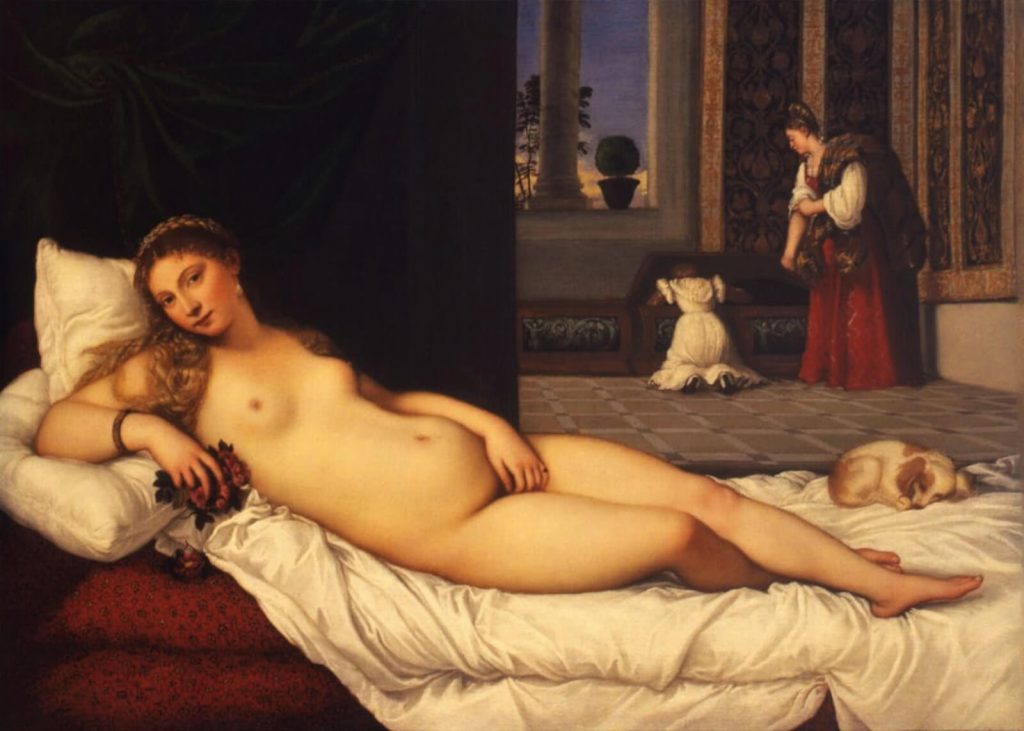
Titian, Venus of Urbino, 1538, Uffizi Gallery, Florence, Italy.
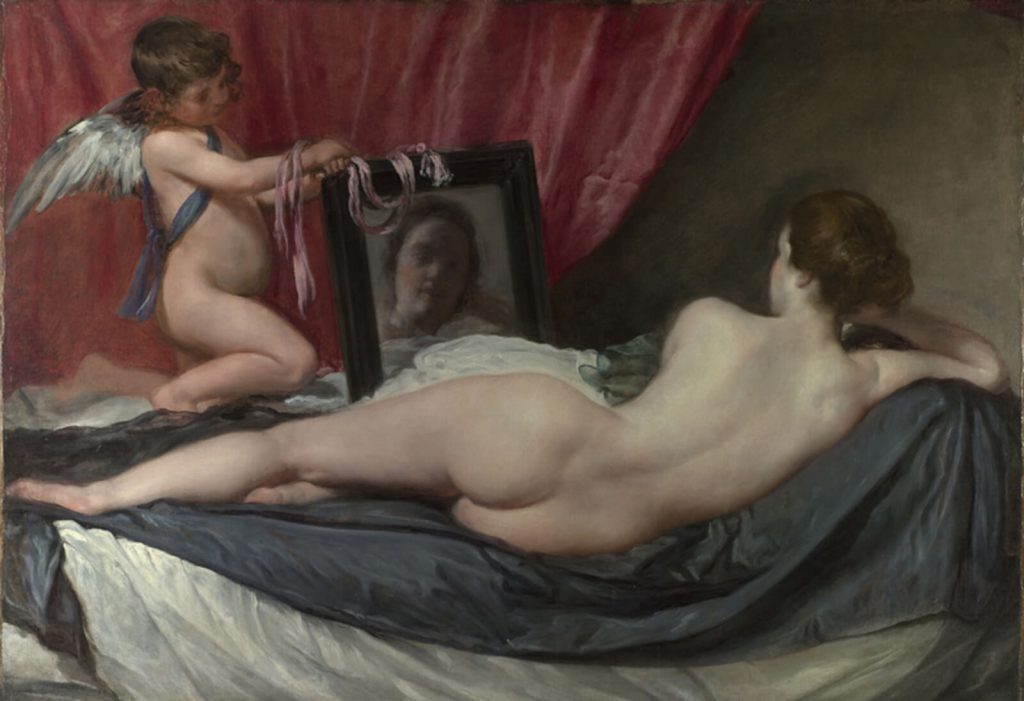
Diego Velázquez, Rokeby Venus, 1647-1651, National Gallery, London, UK.
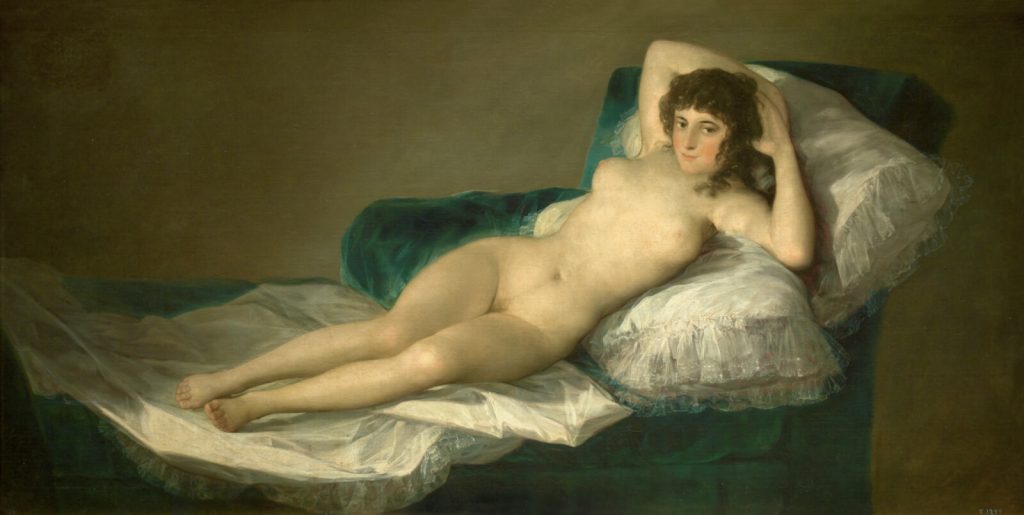
Francisco Goya, Naked Maja, 1795-1800, Museo Nacional del Prado, Madrid, Spain.
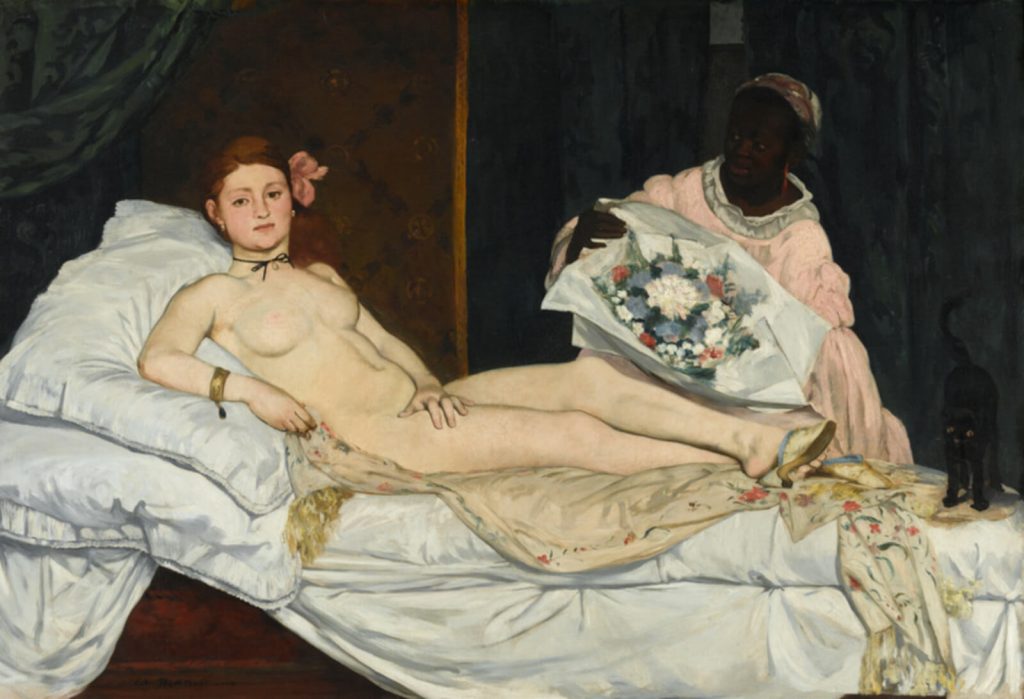
Edouard Manet, Olympia, 1863, Musée d’Orsay, Paris, France.
Giorgione created the Sleeping Venus because he received a commission from Girolamo Marcello, a wealthy Venetian. Marcello was marrying in 1507 and wanted a wedding gift for his bride. During the Italian Renaissance, there was a revival in Latin poetry, and one Latin poem mentions a sleeping Venus who awakes to attend a wedding feast and blesses the newlyweds with love, affection, and fertility. Therefore, Marcello evidently wanted to have his own sleeping Venus at his wedding to bless him and his bride with similar luck.
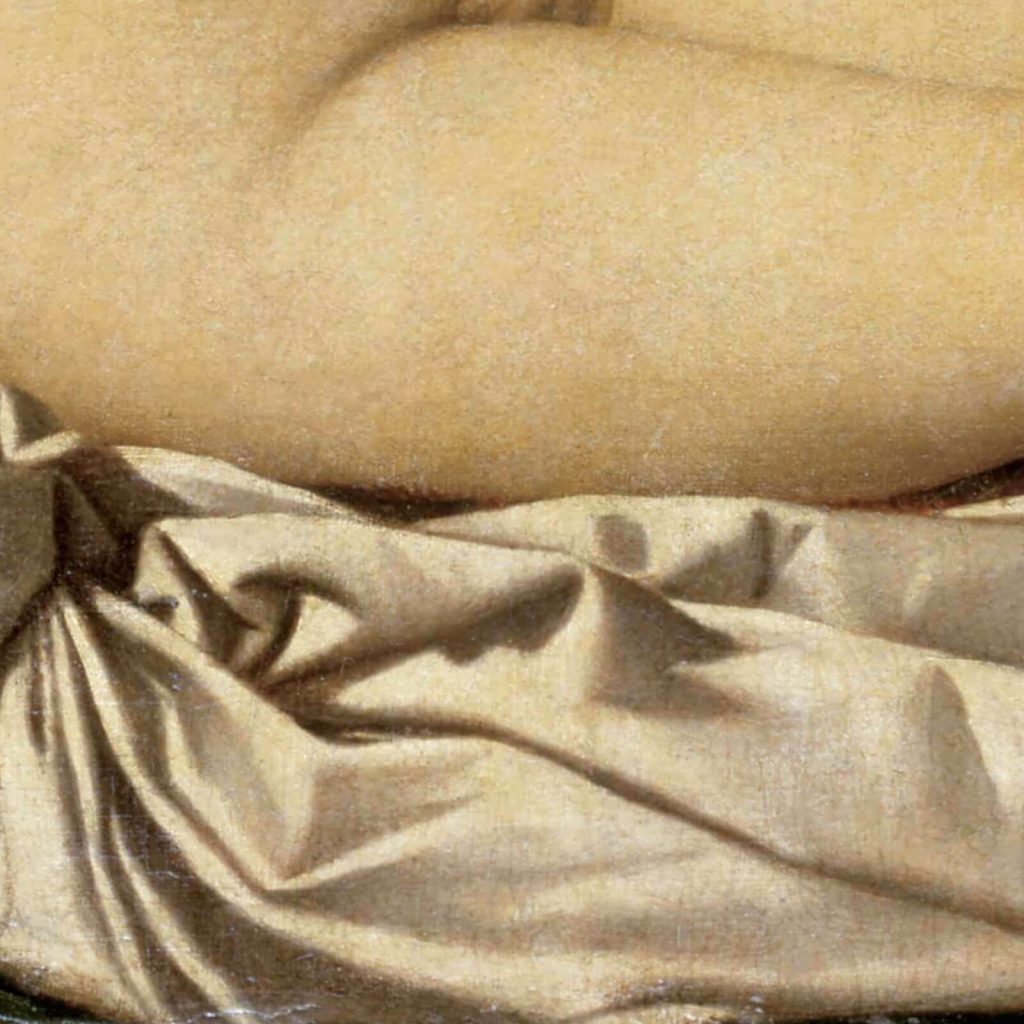
Giorgione and Titian, Sleeping Venus, 1508-1510, Gemäldegalerie Alte Meister, Dresden, Germany. Detail.
The painting is a stunning image of a beautiful woman in a peaceful landscape. The countryside behind her is very similar to the contours of Veneto which is the mainland region of Venice in northeastern Italy. The landscape’s soft wavy hills mirror the goddess’s soft fleshy curves. They create a natural harmony that promotes visual appeal and spiritual contemplation. The landscape also evokes Arcadia which was an ancient district of central Peloponnesus, a peninsula in southern Greece. Arcadia was believed by Renaissance artists to be an unspoiled rural land filled with rustic peace and simplicity. It evoked a sense of dreaminess and a feeling of a lost but never-forgotten paradise. Hence Giorgione blends a familiar Veneto vista with an idyllic Arcadian atmosphere.
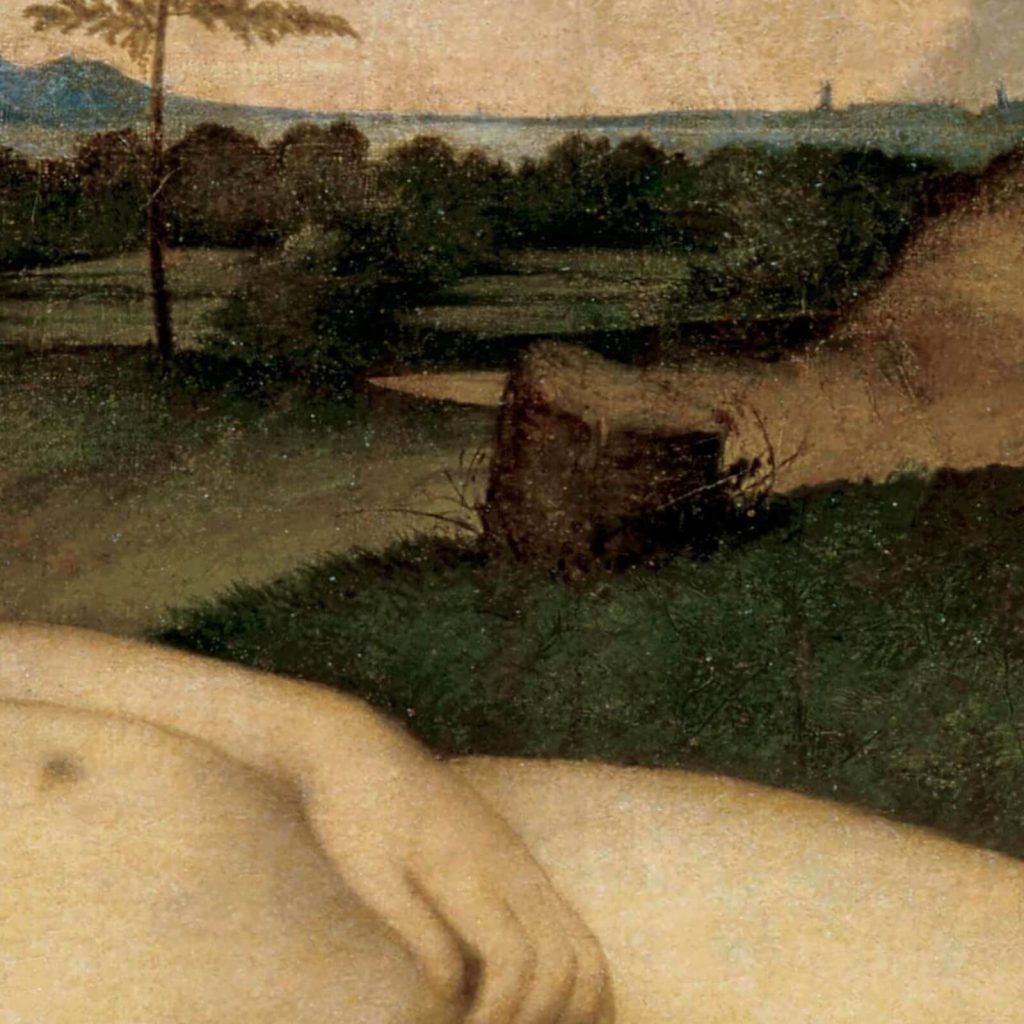
Giorgione and Titian, Sleeping Venus, 1508-1510, Gemäldegalerie Alte Meister, Dresden, Germany. Detail.
The Sleeping Venus is a masterpiece that was begun by Giorgione and finished by his famous contemporary Titian. A record, dated in 1525, states that the Sleeping Venus was not finished by Giorgione due to his untimely death in 1510. He died at the young age of 30 years because he contracted the bubonic plague known contemporarily as the Pestilence and modernly better known as the Black Death. The Great Mortality, the famous pandemic that lasted from 1346 to 1353, was not the end of the bubonic plague. Giorgione fatally contracted it during a smaller outbreak in 1510. Upon his death, his friend and coworker Titian completed the Sleeping Venus to honor Girolamo Marcello’s commission. Many art historians wonder which areas are the result of Titian, but due to multiple restorations over the centuries, the areas of Giorgione and Titian are unidentifiable.
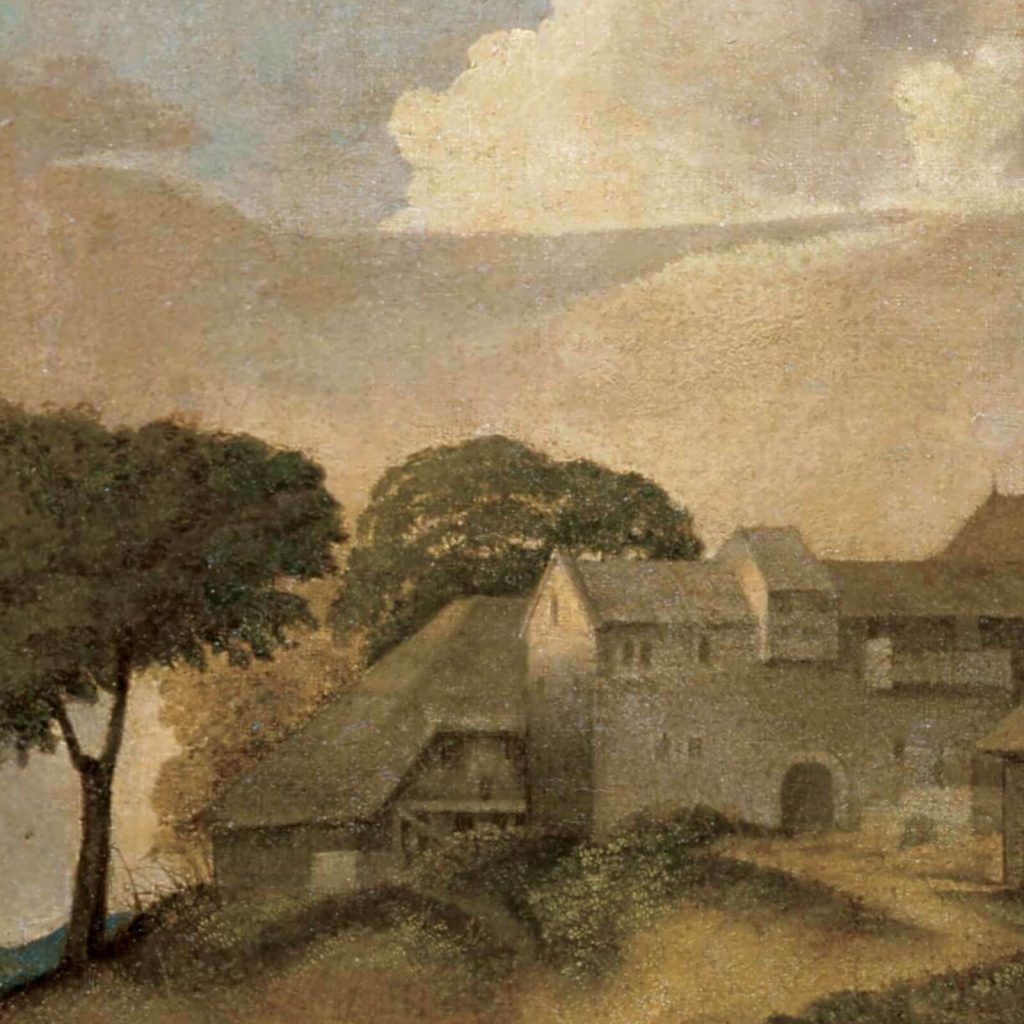
Giorgione and Titian, Sleeping Venus, 1508-1510, Gemäldegalerie Alte Meister, Dresden, Germany. Detail.
Consequently, the Sleeping Venus is attributed to both Giorgione and Titian. Many historians believe Venus and her fabrics are Giorgione’s beginnings and the Arcadian Venetian landscape is Titian’s endings. However, the two artists were so skilled and masterful that differentiating is almost impossible. Regardless, the mixed attribution does not diminish the mastery of the painting. It has survived alterations and botched restorations. It has survived pandemics, wars, and disasters. It is viewed and appreciated by modern visitors. If Giorgione and Titian could view the painting today, what would they think of it? Would they be happy about its survival? Or would they be sad over its altered appearance?
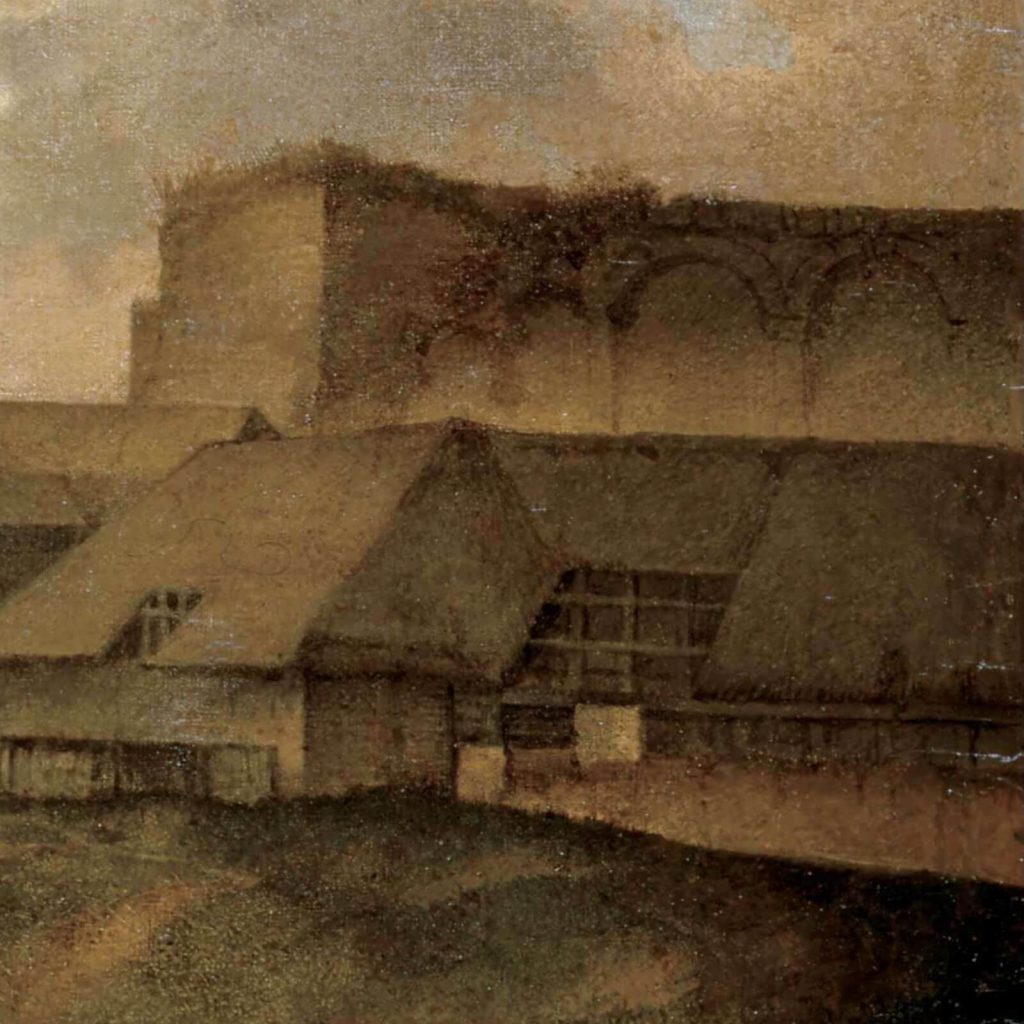
Giorgione and Titian, Sleeping Venus, 1508-1510, Gemäldegalerie Alte Meister, Dresden, Germany. Detail.
10,000 Years of Art, Phaidon Press Limited, London 2009.
Dorsey Armstrong, Black Death: World’s Most Devastating Plague. Documentary Series. Great Courses, Chantilly 2016.
Helen Gardner, Fred S. Kleiner, and Christin J. Mamiya, Gardner’s Art Through the Ages, 12th ed., Thomson Wadsworth, Belmont 2005.
Marcus Lodwick, Museum Companion: Understanding Western Art, Harry N. Abrams, Inc., New York 2003.
Naked Maja, Museo Nacional del Prado Online Collection. Accessed 9 September 2023.
Olympia, Musée d’Orsay Online Collection. Accessed 9 September 2023.
Rokeby Venus, National Gallery Online Collection. Accessed 9 September 2023.
Sleeping Venus, Gemäldegalerie Alte Meister Online Colletion. Accessed 3 September 2023.
Venus of Urbino, Gallerie degli Uffizi Online Collection. Accessed 9 September 2023.
DailyArt Magazine needs your support. Every contribution, however big or small, is very valuable for our future. Thanks to it, we will be able to sustain and grow the Magazine. Thank you for your help!